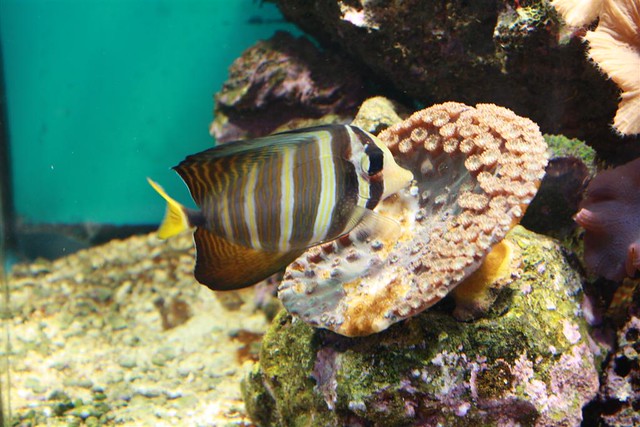Now for the fun part – saltwater aquarium decorations are one aspect of marine fish keeping where you can really allow your creativity to reign free. A variety of decorations are available - from backgrounds, ceramic, resin or plastic ornaments, real or false corals and shells and even plants the sky is (well almost) the limit when it comes to creating a marine world for your fish and other invertebrates.
Saltwater aquarium decorations are fun to buy because unlike the other inhabitants of your tank they don’t require any special care! You won’t need to feed them, provide special habitats and they can’t get sick or die so they are relatively hassle free! A tank without any décor is dull but that’s not all.
 |
| Photo by xAquatics |
A marine tank without any saltwater aquarium decorations is not very exciting AND it can be unhealthy for your fish. Using tank décor makes it possible to break up the physical environment of the tank and is important both for the biological and psycho-social well-being of the fish in your tank. This is because using tank decorations provides hiding places, areas for food to grow on and microbe activity that keeps your tank healthy.
Add to this the fact that saltwater aquarium decorations are nice to look at and fun to work with and you’ll begin to see that décor is essential in any marine tank. The best way to choose your marine tank décor is to visit a store that allows you to see saltwater aquarium decorations in an actual tank, not just on a rack or a table.
Some examples of saltwater aquarium decorations you might like to try in your marine tank are:
Belching clams and treasure chests – These are bubbling and air actuated action ornaments. Spacemen, submarines, clams, and treasure chests are always firm favorites. Even a frog on a log and airstones, are fun saltwater aquarium decorations. The display should be well lit and there should be plenty of bubbles for the best effect!
So what other options are there for saltwater aquarium decorations? What about different and interesting backgrounds? You can purchase a variety of backgrounds like marinescapes, paint-on materials, foils, mirrors and cork stock. You can even buy an in-tank diorama! Display the background effectively and choose tank décor that suits its theme.
Rocks are another good choice for saltwater aquarium decorations. You can choose from sandstones, volcanic and metamorphic rock or even plastic. Some rocks don’t have any impact on water quality while others improve the water quality. If you aren’t sure of a certain rock, play it safe and leave it out. Try pieces of tufa, igneous, silicious/petrified woods), and brackish and African Great Lakes systems calcareous "base" rock. You can usually but rocks by the pound or the ‘piece’. Some rock types are natural while others are artificial.
Driftwood is a great idea for saltwater aquarium decorations. It might be self-sinking or weighted and wither chemically or physically inert or live. Don’t try to cure your own woods. It’s just too time consuming and expensive.
Corals and shells can also be used as saltwater aquarium decorations. Always try to use those from a natural marine source.
Marbles are traditional saltwater aquarium decorations. They can be used underwater – whole circular to flat, marbles and crushed glass are popular in marine tanks. However marbles don’t make for a good biological substrate. They do provide fantastic color to any tank, though.
Faux natural saltwater aquarium decorations are another way of pepping up your marine tank. You can choose from fake rocks, logs, shells, coral, ships and more. Fake they might be but some look quite attractive when arranged properly; so don’t overlook these decorations.
 |
| Chrysiptera parasema, commonly known as the yellowtail damselfish, is a marine fish. (Photo credit: Wikipedia) |
Plastic plants are another option you might want to make use of for your saltwater aquarium decorations. You can obtain some good likenesses of marine plants like sagittaria-turtle grass and vallisneria-zostera for example so don’t overlook them and use them to supplement your real plants while they are growing.
Your choice of saltwater aquarium decorations is up to you but there are some general guidelines to bear in mind when making a choice.
Always make sure that your saltwater aquarium decorations don’t have any sharp edges on which your fish might cut themselves. Never use any substances (rocks, shells etc) that might give off toxic chemicals into the water. Choose shapes and designs that make suitable hiding places for shy animals and good substrates for the growth of marine plants.
Also make sure that your saltwater aquarium decorations are very clean when you put them into your tank. Never use decorations from a tank where the fish or plants are ill or unhealthy in any way. Make sure that there are no spaces within the decorations where fish might get trapped and die.
The best saltwater aquarium decorations don’t have to be particularly fancy. If you like spacemen and frogs go ahead and decorate your tank with them – it’s your tank after all. If you prefer a more elegant style choose natural, rather than faux ornaments and study natural systems and try to duplicate some of these environments in your tank.
You can easily glean this kind of information from books on marine biology or by doing some research on the World Wide Web. The more you learn the more accurate will be the marine world you create and this will make your fish and other invertebrates happy and healthy. The most important thing to remember is to have fun with your saltwater aquarium decorations.
But don’t forget the health of your marine ecosystem. Try to find the proper balance between the aesthetic value of your tank and the well-being of your marine life. The only way to make sure that your stock stay healthy is to study, study, study the fish, invertebrates, plants and make sure you give them what they need to survive. Good luck and enjoy your saltwater aquarium decorations!








